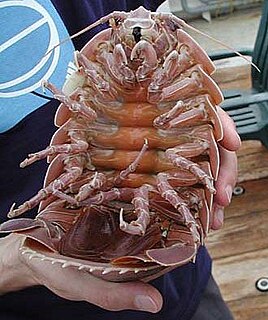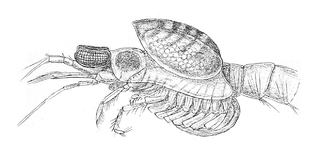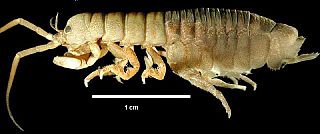
Isopoda is an order of crustaceans that includes woodlice and their relatives. Isopods live in the sea, in fresh water, or on land. All have rigid, segmented exoskeletons, two pairs of antennae, seven pairs of jointed limbs on the thorax, and five pairs of branching appendages on the abdomen that are used in respiration. Females brood their young in a pouch under their thorax.

Bathynomus giganteus is a species of aquatic crustacean, of the order Isopoda. It is a member of the giant isopods (Bathynomus), and it is related—albeit distantly—to shrimps and crabs. It was the first Bathynomus species ever documented, and was described in 1879 by French zoologist Alphonse Milne Edwards after the isopod was found in fishermen's nets off the coast of the Dry Tortugas in the Gulf of Mexico.
Amphoroidea falcifer is an isopod of the family Sphaeromatidae, endemic to New Zealand. It grows up to 14 millimetres (0.55 in), and is found on algae such as Durvillea.

Epicaridea is a former suborder of isopods, now treated as part of the infraorder Cymothoida. They are ectoparasites that inhabit other crustaceans, namely ostracods, copepods, barnacles and malacostracans. The suborder is found globally. Epicaridea are generally less well researched than other isopods.

In zoology, deep-sea gigantism is the tendency for species of invertebrates and other deep-sea dwelling animals to be larger than their shallower-water relatives across a large taxonomic range. Proposed explanations for this type of gigantism include colder temperature, food scarcity, reduced predation pressure and increased dissolved oxygen concentrations in the deep sea. The inaccessibility of abyssal habitats has hindered the study of this topic.

A giant isopod is any of the almost 20 species of large isopods in the genus Bathynomus. They are abundant in the cold, deep waters of the Atlantic, Pacific, and Indian Oceans. Bathynomus giganteus, the species upon which the generitype is based, is often considered the largest isopod in the world, though other comparably poorly known species of Bathynomus may reach a similar size. The giant isopods are noted for their resemblance to the much smaller common woodlouse, to which they are related.

Asellota is a suborder of isopod crustaceans found in marine and freshwater environments. Roughly one-quarter of all marine isopods belong to this suborder. Members of this suborder are readily distinguished from other isopods by their complex copulatory apparatus. Other characteristics include six-jointed antennal peduncle, the styliform uropods, the fusion of pleonites 5, 4 and sometimes 3 to the pleotelson, and absence of the first pleopod in females.
Cirolana mercuryi is a species of isopod found on coral reefs off Bawe Island, in East Africa and named for Freddie Mercury, "arguably Zanzibar's most famous popular musician and singer".

Phreatoicidea is a suborder of isopod crustaceans. Extant species are confined to freshwater environments in South Africa, India, and Oceania. This seemingly Gondwana-derived distribution belies the fact that the group once had a cosmopolitan distribution; fossils which can be assigned to the Phreatoicidea are the oldest isopod fossils, and are found throughout the world. In the intervening 325 million years, phreatoicideans have changed little, and are thus considered living fossils.
The Microcerberidea are a suborder of isopod crustaceans. They are less than 2 mm (0.079 in) long, and live interstitially. They may be found in the eastern Pacific Ocean, and around the coasts of South America, Africa, the Mediterranean Sea, and India.
The Calabozoidae are a family of isopod crustaceans, placed in its own suborder, Calabozoida or Calabozoidea. It comprises two genera, Calabazoa and Pongycarcina.

Cymothoida is the name of a suborder of isopod crustaceans with a mostly carnivorous or parasitic lifestyle. It contains more than 2,700 described species in four superfamilies. Members of the suborder are characterised by their specialised mouthparts which include a mandible with a tooth-like process which is adapted for cutting or slicing.

Sphaeromatidea is a suborder of isopod crustaceans, comprising the following superfamilies and families:
Phoratopus remex is a species of isopod crustaceans known from only two specimens, and first described in 1925 by Herbert Matthew Hale (1895–1963). It lives on the continental shelf at Encounter Bay and Fowlers Bay, South Australia. It is so unlike all other isopods that it is placed in its own family, Phoratopodidae and suborder, Phoratopidea.

The Chaetiliidae are a family of isopod crustaceans in the suborder Valvifera, comprising these genera:

The Entoniscidae are a family of marine isopod crustaceans in the suborder Cymothoida. Members of this family are parasites of brachyuran and anomuran crabs, living in their hosts' haemocoel. A small chitinised hole develops through the host's exoskeleton through which the isopod can communicate with the environment. The female isopod bears little resemblance to any free-living isopod, but the morphology of the larvae show their taxonomic affiliations.
Cymothoa elegans is a species of parasitic isopod in the genus Cymothoa. It has rarely been recorded, with all records coming from the north coast of Java. They are in the arthropod phylum and can more closely be classified as crustaceans.
Scutuloidea maculata is a species of marine isopods in the family Sphaeromatidae, first described by Charles Chilton in 1883. No subspecies are listed in the Catalogue of Life.
Anuropus is a genus of isopods in the suborder Cymothoida. As of 2021, it is the only genus in the family Anuropidae.










